belt SKODA SUPERB 2004 1.G / (B5/3U) Owner's Guide
[x] Cancel search | Manufacturer: SKODA, Model Year: 2004, Model line: SUPERB, Model: SKODA SUPERB 2004 1.G / (B5/3U)Pages: 270
Page 166 of 270

Transporting children safely 165
Using the systemSafetyDriving TipsGeneral MaintenanceBreakdown assistanceTechnical Data
otherwise this may result in injuries to the stomach and neck areas.
Comply with the national legal requirements.
•One should never carry children, and also not babies! - on one's
lap.
•You can transport a child safely in a suitable child safety seat
⇒ page 168, “Child seat”!
•Only one child may be fastened with a seat belt into a child
safety seat.
•Never leave the child sitting unattended in the seat.
•Certain outside climatic conditions can cause life-threatening
temperatures in the vehicle.
•Never allow your child to be transported in a vehicle without the
use of a suitable restraint system.
•Children should also never stand up in a vehicle or kneel on the
seats when the vehicle is moving. In the event of an accident the
child will be thrown through the vehicle and may as a result suffer
fatal injuries, and also injure other occupants.
•Children are exposed to an increased risk of injury in the event
of an accident if they lean forward or adopt an incorrect seated
position when the vehicle is moving . This particularly applies to
children who are transported on the front passenger seat if the
airbag system deploys in the event of an accident. This can result
in severe or even fatal injuries.
•It is important that the belt webb ing is properly routed if the seat
belts are to offer their maximum protection ⇒page 148, “How are
seat belts correctly fastened?”. Pay particular attention to the
information provided by the manufacturer of the child safety seat
regarding correct routing of the belt. Seat belts which are not
correctly adjusted can themselves cause injuries even in minor
accidents.
•Safety belts must be checked to ensure that they are running
properly. One should also ensure that the belt is not damaged by
sharp-edged fittings.
•It is essential to always switch off ⇒page 161 the front
passenger airbag when attaching a child safety seat on the front
passenger seat where the child is seated with its back facing in
direction of travel (in some countries also when the child is facing
the direction of travel). If this is not done, there is a risk of the child
suffering severe or even fatal injuries if the front passenger airbag
is deployed. In certain countries national legal provisions also
require that the side or head passenger airbags be deactivated.
When transporting a child on the front passenger seat, please
comply with the appropriate national regulations regarding the use
of child safety seats.
WARNING (continued)WARNING (continued)
Page 169 of 270
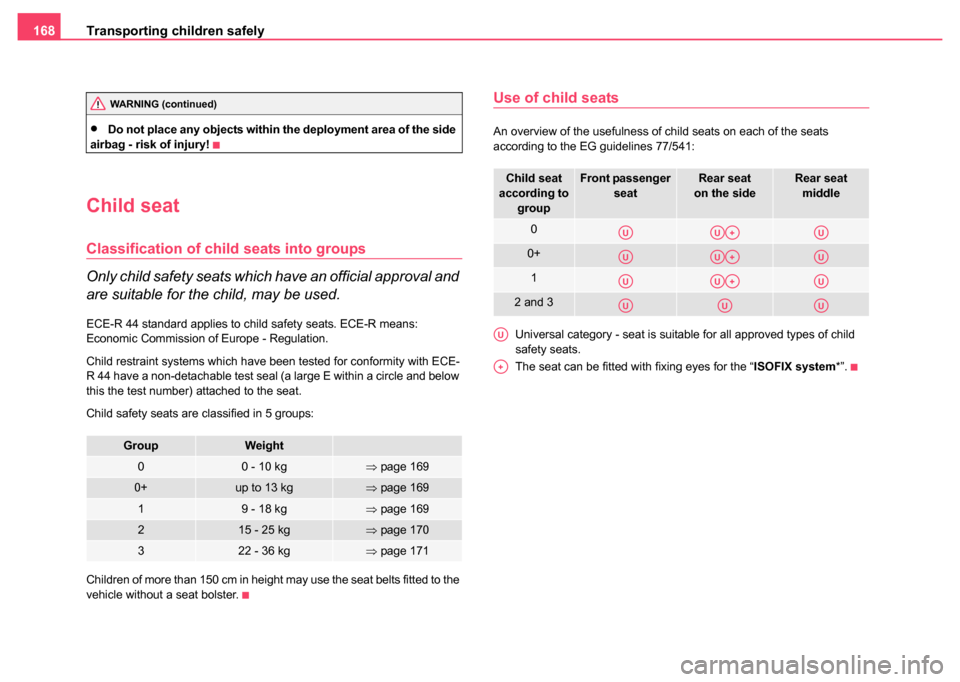
Transporting children safely
168
•Do not place any objects within the deployment area of the side
airbag - risk of injury!
Child seat
Classification of child seats into groups
Only child safety seats which have an official approval and
are suitable for the child, may be used.
ECE-R 44 standard applies to child safety seats. ECE-R means:
Economic Commission of Europe - Regulation.
Child restraint systems which have been tested for conformity with ECE-
R 44 have a non-detachable test seal (a large E within a circle and below
this the test number) attached to the seat.
Child safety seats are classified in 5 groups:
Children of more than 150 cm in height may use the seat belts fitted to the
vehicle without a seat bolster.
Use of child seats
An overview of the usefulness of child seats on each of the seats
according to the EG guidelines 77/541:
Universal category - seat is suitable for all approved types of child
safety seats.
The seat can be fitted with fixing eyes for the “ISOFIX system *”.
GroupWeight
00 - 10 kg⇒page 169
0+up to 13 kg⇒page 169
19 - 18 kg⇒page 169
215 - 25 kg⇒page 170
322 - 36 kg⇒page 171
WARNING (continued)
Child seat
according to groupFront passenger
seatRear seat
on the sideRear seat middle
0
0+
1
2 and 3
AUAUA+AU
AUAUA+AU
AUAUA+AU
AUAUAU
AU
A+
Page 171 of 270

Transporting children safely
170
Child seats in Group 1 are for babies and small children up to 4 years of
age with a weight of between 9 and 18 kilograms. It is best for children in
the lower range of this group, to use a child seat which allows the child to
sit with its back to the direction of travel. It is best for children in the upper
range of the Group 0+, to use a child seat which allows the child to sit
⇒ page 169, fig. 145 in the direction of travel.
Child safety seats in which the child is seated with its back facing the
direction of travel, must not be used on the front passenger seat
⇒ page 166, “Use of child safety seats on the front passenger seat”.
WARNING
•It is essential to always switch off the front passenger airbag
(airbags) when attaching in exceptional circumstances a child
safety seat on the front passenger seat where the child is seated
with its back facing in direction of travel (in some countries also
when the child is facing the direction of travel).
−by allowing a Škoda dealer to do this
− or by using the switch for the front passenger airbag*
⇒ page 162.
•The national legal provisions in certain countries require that
both the front, side and head airbags be deactivated. Please
comply with any differing nationa l legal regulations regarding the
use of child safety seats.
•If this is not done, a child seated on the front passenger seat
may suffer severe or even fatal injuries if the front passenger
airbag or airbags are deployed.
•You should have the front passenger airbag (or airbags) reacti-
vated by your Škoda dealer just as soon as you no longer use a
child safety seat on the front passenger seat.
Child safety seats in Group 2
For children up to about 7 years of age weighing between 15 and 25 kg
the optimal solution is a child safety seat in combination with the three-
point seat belt ⇒fig. 146 .
WARNING
•When transporting a child on the front passenger seat, please
comply with the appropriate national regulations regarding the use
of child safety seats. If required , the airbag has to be deactivated,
− by allowing a Škoda dealer to do this
− or by using the switch for the front passenger airbag*
⇒ page 162.
•The shoulder part of the seat belt must run approximately
across the middle of the shoulder and fit snugly against the chest.
It must on no account run across the neck. The lap part of the seat
belt must run across the pelvis and fits snugly; it must not run over
the belly. Tighten the belt webbing over your hip if necessary.
Fig. 146 Child seat in
Group 2 installed on
the rear seat facing the
direction of travel
Page 172 of 270
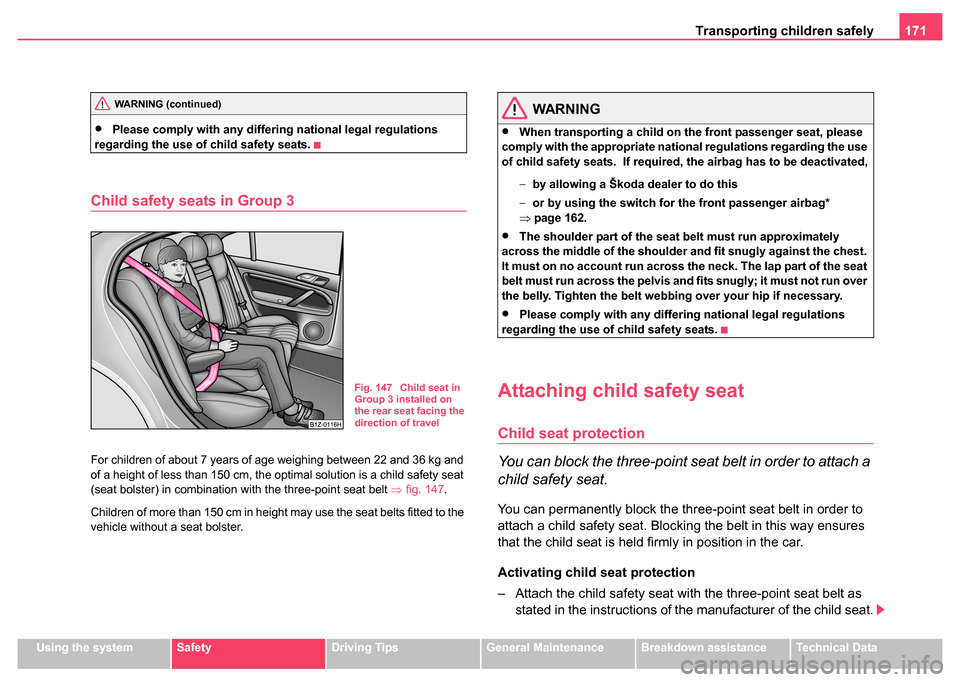
Transporting children safely 171
Using the systemSafetyDriving TipsGeneral MaintenanceBreakdown assistanceTechnical Data
•Please comply with any differin g national legal regulations
regarding the use of child safety seats.
Child safety seats in Group 3
For children of about 7 years of age weighing between 22 and 36 kg and
of a height of less than 150 cm, the optimal solution is a child safety seat
(seat bolster) in combination with the three-point seat belt ⇒fig. 147 .
Children of more than 150 cm in height may use the seat belts fitted to the
vehicle without a seat bolster.
WARNING
•When transporting a child on the front passenger seat, please
comply with the appropriate national regulations regarding the use
of child safety seats. If required, the airbag has to be deactivated,
−by allowing a Škoda dealer to do this
− or by using the switch for the front passenger airbag*
⇒ page 162.
•The shoulder part of the seat belt must run approximately
across the middle of the shoulder and fit snugly against the chest.
It must on no account run across the neck. The lap part of the seat
belt must run across the pelvis and fits snugly; it must not run over
the belly. Tighten the belt webbing over your hip if necessary.
•Please comply with any differ ing national legal regulations
regarding the use of child safety seats.
Attaching child safety seat
Child seat protection
You can block the three-point seat belt in order to attach a
child safety seat.
You can permanently block the three-point seat belt in order to
attach a child safety seat. Blocking the belt in this way ensures
that the child seat is held firmly in position in the car.
Activating child seat protection
– Attach the child safety seat with the three-point seat belt as stated in the instructions of the manufacturer of the child seat.
WARNING (continued)
Fig. 147 Child seat in
Group 3 installed on
the rear seat facing the
direction of travel
Page 173 of 270

Transporting children safely
172
– Now, pull the shoulder part of the belt out fully.
– Insert the tongue of the lock into the seat belt buckle belonging to the seat until it is heard to lock in place.
– Reel up the belt webbing until it is fitted snugly against the child seat. When the belt is reeled up, this can be detected by
a “clicking” noise.
– Pull on the belt in order to check that it is no longer possible to pull out the webbing. The child seat protection is now switched
on.
Deactivating child seat protection
– Press the red button on the seat belt buckle. The tongue of the lock jumps out of the buckle as a result of the spring force
when this is done.
– Guide the belt back with your hand to enable the inertia reel to wind up the belt webbing more easily. The child safety lock is
deactivated after the full reeling up of the belt.
WARNING
It is essential to always switch off ⇒ page 161 the airbag (airbags)
when attaching a child safety seat on the front passenger seat
where the child is seated with its back facing in direction of travel
(in some countries also when the child is facing the direction of
travel). If this is not done, there is a risk of the child suffering severe
or even fatal injuries if the front passenger airbag is deployed. In
certain countries national legal provisions also require that the
side or head passenger airbags be deactivated. When transporting
a child on the front passenger seat, please comply with the appro- priate national regulations regardi
ng the use of child safety seats.
WARNING (continued)
Page 174 of 270
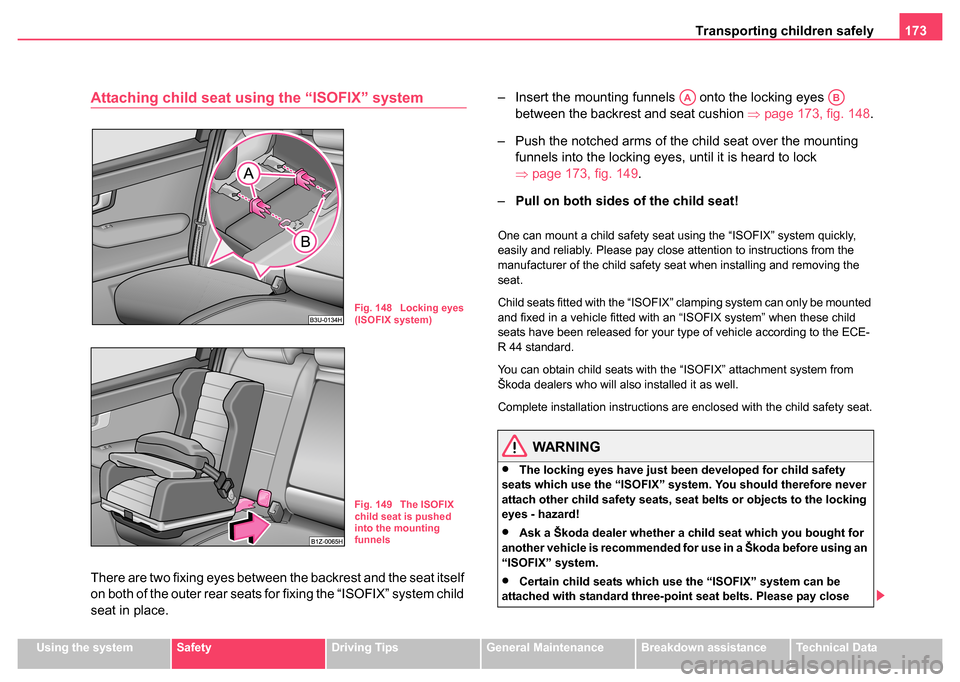
Transporting children safely 173
Using the systemSafetyDriving TipsGeneral MaintenanceBreakdown assistanceTechnical Data
Attaching child seat using the “ISOFIX” system
There are two fixing eyes between the backrest and the seat itself
on both of the outer rear seats for fixing the “ISOFIX” system child
seat in place. – Insert the mounting funnels onto the locking eyes
between the backrest and seat cushion ⇒ page 173, fig. 148.
– Push the notched arms of the child seat over the mounting funnels into the locking eyes, until it is heard to lock
⇒page 173, fig. 149.
– Pull on both sides of the child seat!
One can mount a child safety seat using the “ISOFIX” system quickly,
easily and reliably. Please pay close attention to instructions from the
manufacturer of the child safety seat when installing and removing the
seat.
Child seats fitted with the “ISOFIX” clamping system can only be mounted
and fixed in a vehicle fitted with an “ISOFIX system” when these child
seats have been released for your type of vehicle according to the ECE-
R 44 standard.
You can obtain child seats with the “ISOFIX” attachment system from
Škoda dealers who will also installed it as well.
Complete installation instructions are enclosed with the child safety seat.
WARNING
•The locking eyes have just been developed for child safety
seats which use the “ISOFIX” system. You should therefore never
attach other child safety seats, seat belts or objects to the locking
eyes - hazard!
•Ask a Škoda dealer whether a child seat which you bought for
another vehicle is recommended for use in a Škoda before using an
“ISOFIX” system.
•Certain child seats which use the “ISOFIX” system can be
attached with standard three-point seat belts. Please pay close
Fig. 148 Locking eyes
(ISOFIX system)
Fig. 149 The ISOFIX
child seat is pushed
into the mounting
funnels
AAAB
Page 203 of 270

Care and cleaning
202
– Remove fresh stains which are oil based (e.g. butter, mayon-
naise, chocolate etc.) with an absorbent cloth or household
cleaning paper or with the cleaner from the care set if the stain
has not yet penetrated into the surface.
– Use a grease dissolver for grease stains which have dried
in .
–Eliminate special stains (e.g. ball-point pens, felt pen, nail
varnish, dispersion paint, shoe cream etc.) with a special stain
remover suitable for leather.
Leather care
– Treat the leather every six months with the leather care product available from Škoda dealers.
– Apply only a small amount of the care product.
– Dry the leather off with a soft cloth
It is best to consult your Škoda dealer if you have any questions regarding
cleaning and care of the leather interior.
Caution
•You must on no account treat the leather with solvents (e.g. gasoline,
turpentine), floor wax, shoe cream or such like.
•Avoid leaving your vehicle for lengthy periods in bright sunlight in order
to avoid bleaching the leather. If you leave your vehicle parked in the open
for lengthy periods, protect the leather from the direct rays of the sun by
covering it over.
•Sharp-edged objects on items of clothing such as zip fasteners, rivets,
sharp-edged belts may leave permanent scratches or signs of rubbing on
the surface.
Note
•Use a care cream with light blocker and impregnation effect regularly
and each time after cleaning the leather. The cream nourishes the leather,
allows it to breathe and keeps it supple and also provides moisture. It also
creates surface protection.
•Clean the leather every 2 to 3 months, remove fresh soiling each time
this occurs.
•Remove fresh stains such as those from ball-point pens, ink, lipstick,
shoe cream etc., as quickly as possible.
•Care also for the leather dye. Refreshen areas which have lost their
colour with a special coloured leather cream as required.
Alcantara upholstery
Do not use any leather care products for cleaning Alcantara upholsteries.
Eliminating dust and dirt
Wipe the Alcantara upholstery with a slightly moistened, soft cloth or clean
the covers with a suitable shampoo.
Removing stains
Moisten a soft cloth with lukewarm water or diluted methylated spirits and
dab the stain from the edges toward the middle.
Caution
•Do not use any leather care product on the Alcantara upholsteries.
•Avoid leaving your vehicle for lengthy periods in bright sunlight in order
to avoid bleaching the Alcantara upholsteries. If you leave your vehicle
parked in the open for lengthy periods, protect the Alcantara upholstery
from the direct rays of the sun by covering it over.
Page 204 of 270

Care and cleaning203
Using the systemSafetyDriving TipsGeneral MaintenanceBreakdown assistanceTechnical Data
Seat belts
– Keep the seat belts clean.
– Wash seat belts which have become soiled using a mild soapy
solution.
– Inspect the seat belts regularly to ensure they are in good condition.
Belt webbing which has become severely soiled may prevent the inertia
reel from reeling up the belt properly.
WARNING
•The seat belts must not be removed for cleaning.
•Never clean the seat belts chemically as dry cleaning may
destroy the fabric. The seat belts must also not be allowed to come
into contact with corrosive liquids (such as acids etc.).
•Seat belts which have damage to the webbing, the connections,
the inertia reel or the lock should be replaced by a Škoda dealer.
•Inertia reel belts must be completely dried before being reeled
up.
Page 211 of 270
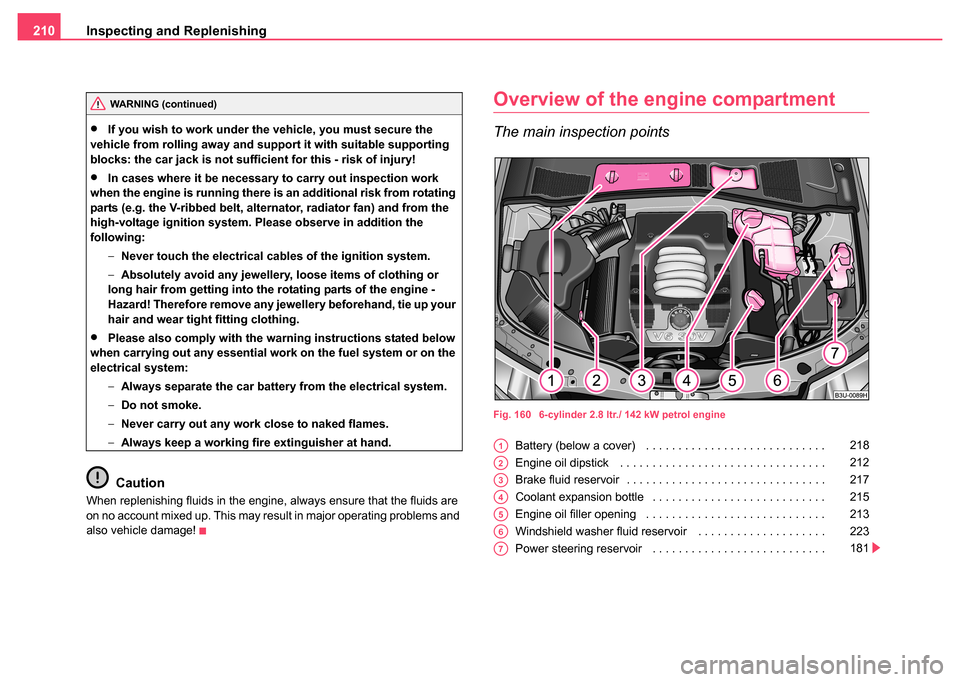
Inspecting and Replenishing
210
•If you wish to work under the vehicle, you must secure the
vehicle from rolling away and support it with suitable supporting
blocks: the car jack is not sufficient for this - risk of injury!
•In cases where it be necessary to carry out inspection work
when the engine is running there is an additional risk from rotating
parts (e.g. the V-ribbed belt, alternator, radiator fan) and from the
high-voltage ignition system. Pl ease observe in addition the
following:
−Never touch the electrical cables of the ignition system.
− Absolutely avoid any jewellery, loose items of clothing or
long hair from getting into the rotating parts of the engine -
Hazard! Therefore remove any jewellery beforehand, tie up your
hair and wear tight fitting clothing.
•Please also comply with the warning instructions stated below
when carrying out any essential work on the fuel system or on the
electrical system:
−Always separate the car battery from the electrical system.
− Do not smoke.
− Never carry out any work close to naked flames.
− Always keep a working fire extinguisher at hand.
Caution
When replenishing fluids in the engine, always ensure that the fluids are
on no account mixed up. This may result in major operating problems and
also vehicle damage!
Overview of the engine compartment
The main inspection points
Fig. 160 6-cylinder 2.8 ltr./ 142 kW petrol engine
Battery (below a cover) . . . . . . . . . . . . . . . . . . . . . . . . . . . .
Engine oil dipstick . . . . . . . . . . . . . . . . . . . . . . . . . . . . . . . .
Brake fluid reservoir . . . . . . . . . . . . . . . . . . . . . . . . . . . . . . .
Coolant expansion bottle . . . . . . . . . . . . . . . . . . . . . . . . . . .
Engine oil filler opening . . . . . . . . . . . . . . . . . . . . . . . . . . . .
Windshield washer fluid reservoir . . . . . . . . . . . . . . . . . . . .
Power steering reservoir . . . . . . . . . . . . . . . . . . . . . . . . . . .
WARNING (continued)
A1218
A2212
A3217
A4215
A5213
A6223
A7181
Page 262 of 270
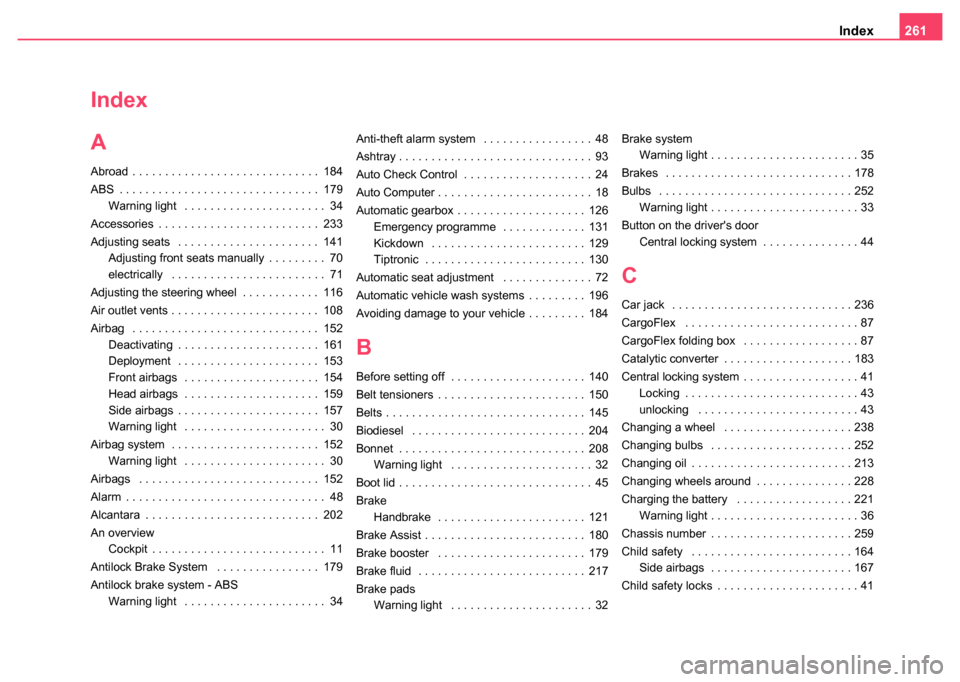
Index261
Index
A
Abroad . . . . . . . . . . . . . . . . . . . . . . . . . . . . . 184
ABS . . . . . . . . . . . . . . . . . . . . . . . . . . . . . . . 179
Warning light . . . . . . . . . . . . . . . . . . . . . . 34
Accessories . . . . . . . . . . . . . . . . . . . . . . . . . 233
Adjusting seats . . . . . . . . . . . . . . . . . . . . . . 141 Adjusting front seats manually . . . . . . . . . 70
electrically . . . . . . . . . . . . . . . . . . . . . . . . 71
Adjusting the steering wheel . . . . . . . . . . . . 116
Air outlet vents . . . . . . . . . . . . . . . . . . . . . . . 108
Airbag . . . . . . . . . . . . . . . . . . . . . . . . . . . . . 152 Deactivating . . . . . . . . . . . . . . . . . . . . . . 161
Deployment . . . . . . . . . . . . . . . . . . . . . . 153
Front airbags . . . . . . . . . . . . . . . . . . . . . 154
Head airbags . . . . . . . . . . . . . . . . . . . . . 159
Side airbags . . . . . . . . . . . . . . . . . . . . . . 157
Warning light . . . . . . . . . . . . . . . . . . . . . . 30
Airbag system . . . . . . . . . . . . . . . . . . . . . . . 152 Warning light . . . . . . . . . . . . . . . . . . . . . . 30
Airbags . . . . . . . . . . . . . . . . . . . . . . . . . . . . 152
Alarm . . . . . . . . . . . . . . . . . . . . . . . . . . . . . . . 48
Alcantara . . . . . . . . . . . . . . . . . . . . . . . . . . . 202
An overview Cockpit . . . . . . . . . . . . . . . . . . . . . . . . . . . 11
Antilock Brake System . . . . . . . . . . . . . . . . 179
Antilock brake system - ABS Warning light . . . . . . . . . . . . . . . . . . . . . . 34 Anti-theft alarm system . . . . . . . . . . . . . . . . . 48
Ashtray . . . . . . . . . . . . . . . . . . . . . . . . . . . . . . 93
Auto Check Control . . . . . . . . . . . . . . . . . . . . 24
Auto Computer . . . . . . . . . . . . . . . . . . . . . . . . 18
Automatic gearbox . . . . . . . . . . . . . . . . . . . . 126
Emergency programme . . . . . . . . . . . . . 131
Kickdown . . . . . . . . . . . . . . . . . . . . . . . . 129
Tiptronic . . . . . . . . . . . . . . . . . . . . . . . . . 130
Automatic seat adjustment . . . . . . . . . . . . . . 72
Automatic vehicle wash systems . . . . . . . . . 196
Avoiding damage to your vehicle . . . . . . . . . 184
B
Before setting off . . . . . . . . . . . . . . . . . . . . . 140
Belt tensioners . . . . . . . . . . . . . . . . . . . . . . . 150
Belts . . . . . . . . . . . . . . . . . . . . . . . . . . . . . . . 145
Biodiesel . . . . . . . . . . . . . . . . . . . . . . . . . . . 204
Bonnet . . . . . . . . . . . . . . . . . . . . . . . . . . . . . 208 Warning light . . . . . . . . . . . . . . . . . . . . . . 32
Boot lid . . . . . . . . . . . . . . . . . . . . . . . . . . . . . . 45
Brake Handbrake . . . . . . . . . . . . . . . . . . . . . . . 121
Brake Assist . . . . . . . . . . . . . . . . . . . . . . . . . 180
Brake booster . . . . . . . . . . . . . . . . . . . . . . . 179
Brake fluid . . . . . . . . . . . . . . . . . . . . . . . . . . 217
Brake pads Warning light . . . . . . . . . . . . . . . . . . . . . . 32 Brake system
Warning light . . . . . . . . . . . . . . . . . . . . . . . 35
Brakes . . . . . . . . . . . . . . . . . . . . . . . . . . . . . 178
Bulbs . . . . . . . . . . . . . . . . . . . . . . . . . . . . . . 252 Warning light . . . . . . . . . . . . . . . . . . . . . . . 33
Button on the driver's door Central locking system . . . . . . . . . . . . . . . 44
C
Car jack . . . . . . . . . . . . . . . . . . . . . . . . . . . . 236
CargoFlex . . . . . . . . . . . . . . . . . . . . . . . . . . . 87
CargoFlex folding box . . . . . . . . . . . . . . . . . . 87
Catalytic converter . . . . . . . . . . . . . . . . . . . . 183
Central locking system . . . . . . . . . . . . . . . . . . 41Locking . . . . . . . . . . . . . . . . . . . . . . . . . . . 43
unlocking . . . . . . . . . . . . . . . . . . . . . . . . . 43
Changing a wheel . . . . . . . . . . . . . . . . . . . . 238
Changing bulbs . . . . . . . . . . . . . . . . . . . . . . 252
Changing oil . . . . . . . . . . . . . . . . . . . . . . . . . 213
Changing wheels around . . . . . . . . . . . . . . . 228
Charging the battery . . . . . . . . . . . . . . . . . . 221 Warning light . . . . . . . . . . . . . . . . . . . . . . . 36
Chassis number . . . . . . . . . . . . . . . . . . . . . . 259
Child safety . . . . . . . . . . . . . . . . . . . . . . . . . 164 Side airbags . . . . . . . . . . . . . . . . . . . . . . 167
Child safety locks . . . . . . . . . . . . . . . . . . . . . . 41